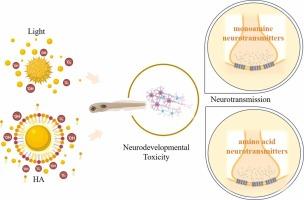Enhancing Effect of Humic Acid on Neurodevelopmental Impact of Cadmium Sulfide Nanoparticles to Zebrafish
IF 11.3
1区 环境科学与生态学
Q1 ENGINEERING, ENVIRONMENTAL
引用次数: 0
Abstract
Metal sulfide nanoparticles (MSNPs) are widespread in aquatic environments, where their stability and toxicity are affected by environmental factors. However, the role of dissolved organic matter (DOM) in modulating oxidative transformation and toxicity of MSNPs remains poorly understood. Here, we investigated the chemical stability and neurodevelopmental toxicity of cadmium sulfide nanoparticles (CdSNPs) in zebrafish, focusing on the effects of humic acid (HA), a representative DOM. Our results demonstrate that light promoted the generation of reactive oxygen species (ROS), thus accelerating CdSNPs dissolution and increasing cadmium uptake. However, the photoinduced release of cadmium ions was significantly decreased by HA, due to the formation of surface coating, thus inhibiting CdSNPs dissolution and decreasing cadmium uptake. Despite these opposing effects on cadmium release and uptake, light and HA did not proportionally influence the neurodevelopmental outcomes in zebrafish, as shown by behavioral response of transgenic line. The nanoparticulate form of CdSNPs and HA themselves also contributed substantially to neurotoxicity. Targeted metabolomic analyses revealed that these effects were mediated by disturbances in dopaminergic, glutamatergic, GABAergic, and glycinergic neurotransmission, with HA further enhancing the disruption of key enzymes and receptors involved in these systems. These findings provide new insights into environmental behavior and neurotoxic potential of MSNPs, informing their ecological risk assessment in natural aquatic systems.

腐植酸对硫化镉纳米颗粒对斑马鱼神经发育影响的增强作用
金属硫化物纳米颗粒广泛存在于水生环境中,其稳定性和毒性受环境因素的影响。然而,溶解有机物(DOM)在调节msnp氧化转化和毒性中的作用仍然知之甚少。在这里,我们研究了硫化镉纳米颗粒(cdsnp)在斑马鱼中的化学稳定性和神经发育毒性,重点研究了典型DOM腐植酸(HA)的影响。我们的研究结果表明,光促进活性氧(ROS)的产生,从而加速cdsnp的溶解和增加镉的吸收。然而,由于表面形成涂层,透明质酸显著降低了镉离子的光诱导释放,从而抑制了cdsnp的溶解,降低了镉的吸收。尽管对镉的释放和吸收有相反的影响,但光和透明质酸对斑马鱼的神经发育结果没有成比例的影响,转基因品系的行为反应表明了这一点。CdSNPs和HA本身的纳米粒形式也对神经毒性有很大贡献。靶向代谢组学分析显示,这些作用是由多巴胺能、谷氨酸能、gaba能和甘氨酸能神经传递的干扰介导的,而透明质酸进一步增强了对这些系统中关键酶和受体的破坏。这些发现为msnp的环境行为和神经毒性潜力提供了新的见解,为其在自然水生系统中的生态风险评估提供了信息。
本文章由计算机程序翻译,如有差异,请以英文原文为准。
求助全文
约1分钟内获得全文
求助全文
来源期刊

Journal of Hazardous Materials
工程技术-工程:环境
CiteScore
25.40
自引率
5.90%
发文量
3059
审稿时长
58 days
期刊介绍:
The Journal of Hazardous Materials serves as a global platform for promoting cutting-edge research in the field of Environmental Science and Engineering. Our publication features a wide range of articles, including full-length research papers, review articles, and perspectives, with the aim of enhancing our understanding of the dangers and risks associated with various materials concerning public health and the environment. It is important to note that the term "environmental contaminants" refers specifically to substances that pose hazardous effects through contamination, while excluding those that do not have such impacts on the environment or human health. Moreover, we emphasize the distinction between wastes and hazardous materials in order to provide further clarity on the scope of the journal. We have a keen interest in exploring specific compounds and microbial agents that have adverse effects on the environment.
 求助内容:
求助内容: 应助结果提醒方式:
应助结果提醒方式:


